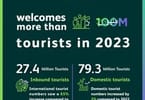BANGKOK, Thailand – The Pacific Asia Travel Association (PATA) today released preliminary results of international visitor arrivals into Asia/Pacific destinations1 for April 2011. The figures show a year-on-year increase for the month of 6.8%, generating an additional 1.8-million arrivals. This result was partly affected by a comparison with the lower numeric base of April 2010, during which the volcanic ash crisis hampered air travel but also by the continuing strength of arrivals from South Asia and Southeast Asia. These factors offset recent weakness in the Japan outbound market and declines in arrivals from the Middle East.
The April result means that for the first four months of 2011, international visitor arrivals to the region grew by 5.4% year-on-year adding more than 5.5-million arrivals to the collective inbound count.
The latest month for which full figures are available, April 2011, shows that arrivals to South Asia surged by 24%, with many destinations in the sub-region reporting double-digit growth – Sri Lanka (+67%), Nepal (+34%), Maldives (+32%) and India (+18%). These robust results were due mainly to a strong rebound in arrivals from Europe and North America and the continued strength in the Asian and Middle East source markets.
Similarly for Southeast Asia where international arrivals grew by a healthy 15% in April in spite of the weakness in Japan, one of its key source markets in Asia. Intra-regional travel remained strong and overall growth for the sub-region was further boosted by the rebound in arrivals from Europe and the fast-growing China market. Arrivals to Thailand rebounded by 35% from a poor April 2010 when the destination was severely affected by political unrest. Double-digit growth in arrivals was also reported by Vietnam (+22%), Myanmar (+21%), Singapore (+17%) and Cambodia (+11%) for the month of April.
Conversely, growth in arrivals to Northeast Asia although remaining positive, was none the less sluggish at 4% for the month, largely as a consequence of the sharp 63% decline in arrivals to Japan. The remaining destinations in the sub-region all recorded positive growth – China (+4%), Hong Kong SAR (+20%), Korea (ROK) (+3%) and Macau SAR (+11%). However, it was evident that slower growth into most of these destinations was in part caused by the decline in the number of outbound trips from Japan.
Travel demand to the Pacific grew overall by 5% in April, year-on-year, assisted by the UK-led recovery in arrivals to Australia (+8%) and New Zealand (+5%). Arrivals to Guam (–14%), the Marshall Islands (–15%) and the Northern Marianas (–18%) however showed significant declines due in large part to the substantial decreases in arrivals from their main source market of Japan.
Kris Lim, Director of the Strategic Intelligence Centre, PATA, said: “Positive growth in foreign arrivals continues for many Asia/Pacific destinations. The March 11 earthquake, tsunami and nuclear plant safety issues are still impacting Japan’s tourism sector.”
The latest results from the JNTO for May 2011 showed some small signs of recovery with lower negative growth of inbound and outbound travellers when compared to previous months.
Lim added: “We believe that Japan will gradually see more improvementthrough the second half of the year.”
PATA also revealed that intra-regional flows within Asia are still the main driving force as they expanded at double-digit growth rates for the first four months of the year. Increases in arrivals from the Pacific and Europe, especially France and the Russian Federation, also continued to support tourism growth in the Asia/Pacific region.
WHAT TO TAKE AWAY FROM THIS ARTICLE:
- Conversely, growth in arrivals to Northeast Asia although remaining positive, was none the less sluggish at 4% for the month, largely as a consequence of the sharp 63% decline in arrivals to Japan.
- Similarly for Southeast Asia where international arrivals grew by a healthy 15% in April in spite of the weakness in Japan, one of its key source markets in Asia.
- Arrivals to Guam (–14%), the Marshall Islands (–15%) and the Northern Marianas (–18%) however showed significant declines due in large part to the substantial decreases in arrivals from their main source market of Japan.






















